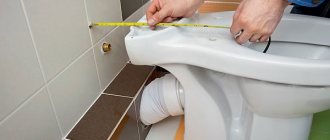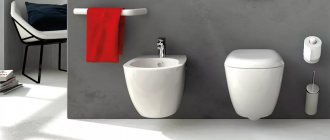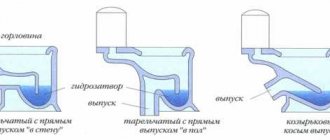The plumbing in the house is the most vulnerable place in the apartment.
If the toilet fails, it is akin to a disaster. In most cases, it is better to replace the toilet with a new one. Replacing a toilet with your own hands is a labor-intensive process, but anyone can do it. There are general instructions for replacing this plumbing item. If the toilet is equipped with modern plastic pipes, then the broken toilet is dismantled, a similar model is purchased, all that remains is to attach it to the old place. If the pipes are Soviet-style, then the work will become more complicated; the sewer pipes may have to be replaced .
How do you know when it's time to change the toilet?
At first glance, the wording may seem strange. Anyone understands that the toilet needs to be replaced when it is out of order. But in fact, most problems associated with malfunctions of the sewer system and the toilet in particular can be eliminated without replacing the plumbing.
The most common problems that occur are:
- leaks from the tank;
- flows from under the bowl;
- cracks on ceramics;
- unpleasant smell from the sewer.
If water is constantly leaking from your tank, this is a serious reason to think about it. This wasteful use of water contradicts the modern trend of protecting the environment and saving natural resources. If the tank drips onto the floor and you are tired of replacing basins, but all pipe connections are normal, most likely the culprit is a chip or crack.
In this case, you can only temporarily solve the problem, but replacing the toilet should be done as soon as possible. But if water from the tank flows down the wall of the bowl into the sewer, good news, most likely there is no need to change the plumbing.
The cause of this malfunction is often a leaky valve. Luckily, the entire interior of the cistern is sold separately and can simply be replaced.
Plumbing faience and porcelain are fragile materials that are not resistant to sudden temperature changes. The enamel can become covered with a network of cracks, which not only spoil the aesthetic appearance, but also threaten to destroy the entire product.
Such a crack is a bad sign. It could have appeared as a result of something heavy falling or simply from a temperature change
If cracks or chips appear on the toilet, try to replace it as soon as possible. You never know at what point ceramics will not hold up and will burst under the weight of a person, exposure to water, or simply from internal stress.
It’s good if someone is nearby at this moment and can quickly eliminate the consequences of the disaster, otherwise you can count on the upcoming repairs in the toilet of the neighbors below.
In this case, everything is already clear - there will be a replacement! Unfortunately, this happens very often and not only with old toilets.
An unpleasant sewer smell in the toilet is another bad sign. This is often caused by improper placement of pipes when wastewater is retained in the sewer system. But if you are convinced that everything is in order with the pipeline and you can be sure that the earthenware is clean, look for the reason in the destruction of the glossy coating of the ceramics.
If the enamel has corroded and porous sanitaryware begins to come into contact with dirty drains, it will soon begin to absorb and absorb unpleasant odors. It is no longer possible to remove them; such destruction is an irreversible process. Here you cannot do without a complete replacement of plumbing.
Replacing a toilet during a complete bathroom refurbishment is just one of the stages. Think in advance about a place for new plumbing to remove water supply and sewerage
Another reason to change the toilet is renovation of the toilet. Few people want to leave the old plumbing when completely redesigning their bathroom. This is certainly a pleasant occasion.
New models of plumbing appear regularly, and it is difficult to keep up with fashion. Whether you choose a classic model or an unusual piece from a fashion catalog, the replacement will be carried out according to the same principle.
Preparing for installation
The plumbing product must be installed in a prepared place. First of all, you need to assess the condition of the floor and sewer pipe.
There should be a flat surface under the toilet, usually a screed lined with floor tiles or porcelain stoneware.
The outlet to the sewer must be cleaned of old deposits and dirt and its angle of inclination must be determined.
You need to pay attention to the water socket. A tap must be installed on it to be able to turn off the water supply if necessary.
What should you prepare in advance?
Before you replace an old toilet with your own hands, you need to prepare for the work. You need to think through everything especially carefully if the replacement is carried out in a toilet that continues to be used. In this situation, you need to replace the plumbing quickly, and without proper organization this is impossible.
Choose the appropriate model, prepare all the necessary tools and supplies, and then you can get to work.
Choosing the type of new toilet
The most important thing is to buy a new toilet. Then, depending on your choice, a set of tools and materials for replacement will be selected.
The following types are distinguished:
- floor;
- hanging.
Floor models . Such bowls are more common and their choice is very wide. Replacing an old floor-standing toilet with a new one is the most common story. There are floor-standing models such as “monoblock”, “compact”, separate bowl and tank, as well as with a hidden drain system.
The monoblock toilet is stylish, but not practical. If the tank fails, the entire system will have to be replaced. This won't happen with a compact.
A monoblock is a product that combines both a bowl and a tank. A compact toilet is when the tank and bowl are supplied as a set and are connected during installation. This is the most popular option in our plumbing products market.
The retro model, when the tank is located under the ceiling and connected to the toilet by a pipeline, and to flush it you need to “pull the string,” is becoming less and less common. It looks good in an interior of the appropriate style.
A modern option is a hidden drain system. To replace a regular toilet with this one, you will need to build a false wall, behind which the cistern with the installation system will be hidden. Externally, such models look very neat; only the drain button is located on the wall, and all communications are hidden.
Thanks to its placement on the wall, the toilet appears to float in the air. But it is not attached to the wall, but to a steel frame that is hidden in the wall. Withstands weight up to 400 kg
Hanging bowls . Such toilets are not installed on the floor; they are hung on special anchor bolts on the wall. This leaves free space under the bowl that can be put to good use.
And from a hygienic point of view, this design wins. Cleaning the floor under a wall-mounted toilet is easy, but dirt often collects around the floor-mounted toilet.
Another detail that is important to consider when replacing a toilet with your own hands is the direction of release.
There are 3 varieties:
- release at an angle;
- straight;
- vertical.
A popular option is direct horizontal release. The toilet is connected to the sewer pipe at the same level. Oblique release was used in Soviet multi-story construction, but is still found today.
Externally, toilets may look exactly the same, but due to the different location of the outlet, you need to be careful when choosing
But devices with vertical drainage are installed more often in America and China. The convenience lies in the fact that the toilet can be placed at any point; communications are provided inside the interfloor ceiling. With us this is possible in private homes.
Practical tips for choosing a toilet are outlined in this article.
A set of necessary tools for work
The set of plumbing tools for replacing an old toilet is standard. Depending on the condition of the old equipment that will have to be dismantled and the sewer pipes, as well as the chosen method of attaching the new plumbing fixture, the set of tools needed may vary slightly.
Prepare the following necessary items:
- perforator;
- adjustable wrench;
- screwdriver;
- a hacksaw or grinder;
- sealant gun;
- hammer and chisel;
- rubber spatula;
- building level;
- personal protective equipment – glasses, gloves.
A hammer drill will be needed to knock out holes in the concrete for the dowels on which the new toilet will be attached. Work on connecting the water supply is carried out using an adjustable wrench. To tighten the screws, you will need a flat-head or Phillips screwdriver, and to seal the joints, you will need a gun for a can of sealant.
When disassembled, a modern compact toilet looks like this. A set of fasteners, rubber O-rings and a tank drain mechanism can be packaged separately. No need to be scared, it all comes together like a construction set
A hammer and chisel may come in handy if the equipment was connected to an old Soviet cast iron sewer riser. To ensure that the bowl is level, use a building level.
List of required materials
In addition to a set of tools for replacing a toilet with your own hands, you need to purchase additional materials that will be needed during installation:
- sealant;
- corrugation for connection to the riser;
- pipe for connecting to the water supply;
- FUM tape;
- tap;
- mounting kit
In any plumbing issue, the moment of sealing is the most important. Any gap or loose connection threatens leakage.
Silicone sealant in a bottle is your best friend when replacing a toilet. They fill all the cracks and gaps, process connections
To connect a plumbing fixture to the sewer, you need to buy a special plastic corrugated pipe. This is convenient because the pipe is flexible and fits in most cases. It can be bent to any position, stretched and compressed.
The corrugated pipe for connecting the toilet to the sewer is universal. It is suitable for both horizontal and angled release. Bowls with vertical drainage are connected in a special way - using a special elastic cuff
To seal the joints, use sealing tape or tow - the old fashioned way. The mounting kit for replacing a toilet includes dowels, screws, bolts, washers, nuts, plugs for connecting all components and installation. Don't be alarmed if something is missing, you can buy it all separately.
Material
Before replacing the toilet with your own hands, it is recommended that you familiarize yourself with the characteristics. For manufacturing, 4 types of materials are used:
- faience;
- acrylic;
- porcelain;
- cast iron.
Earthenware in this group is the most fragile raw material with a low level of resistance to mechanical stress. The raw material base is white clay with special additives.
To protect against the effects of aggressive environments, faience is coated with a layer of glaze. The service life is 15 years.
Removing an old toilet
To replace an old toilet with a new one, you must first dismantle the equipment. If the plumbing is not too old, most likely there will be no problems with dismantling.
It’s another matter if the plumbing is actually very old, and the sewer pipes are cast iron, Soviet-style. This is where you have to work hard. But first things first.
If the old plumbing fixtures are not concreted into the floor, consider yourself lucky. A toilet mounted on a wooden stand is easier to remove. The remains of the wood will need to be removed and the hole in the floor will need to be filled with screed
If everything is not so bad, and the toilet is not that old, replacing it will be easier:
- Shut off the water supply. Drain the water from the tank.
- Prepare a bucket and rags.
- Disconnect the tank by unscrewing the bolts from below.
- Remove the corrugation or plastic eccentric that connects the bowl outlet to the sewer.
- Remove any remaining water from the bowl using a regular sponge.
- Look at the fasteners on the sides of the base. There should be 2 or 4 of them. Unscrew them with a wrench.
- Use a knife to remove the silicone sealant from under the base.
- Remove the bowl from the tile.
In the last century, they tried to make repairs “for centuries”, thoroughly. And plumbing installation was no exception.
You can often find toilets in apartments mounted on mortar, embedded in a screed, wrapped with rags at the base and covered with several layers of paint. In this case, the connection with the pipe is covered with a thick layer of cement. Now it seems funny, until you personally encounter the replacement of such a rarity.
If you can't unscrew it, you'll have to beat it. Be careful, do not forget to protect your eyes and hands from fragments of earthenware
If you don’t mind the ceramics, you can dismantle it in parts. This is where a hammer and chisel come in handy. Tap the area where the bowl meets the pipe while rocking the mount.
If it doesn’t give in, hit the neck of the toilet more boldly, it will crack. Now it can be removed. Just don’t hit the cast iron pipe with a hammer, it is also very fragile and can crack.
Image gallery
Photo from
Old plumbing fixtures on tile floor
Using taffeta with concrete screed
Connection to the sewer with a cast iron pipe
Repairing the floor before installing a new toilet
Preparatory work
Before changing the toilet yourself, remove the old one. If a new product is being dismantled, the process will not take much time. First, the water supply is cut off. Next, the bolts and connecting tee are removed. Carefully remove the bowl and drain tank.
Replacing an old-style toilet will require patience and accuracy. In houses that are more than 30 years old, utilities are more complex. In addition, they suggested filling the joint with cement. Here's how it works step by step:
- Turn off the drain tank, drain the water, remove the lid.
- Unscrew the corrugation and collect any remaining moisture inside the water seal.
- Use blows to break the junction of the neck and tee, avoiding hitting the neck. Using a hammer drill will speed up the process and improve the quality of work.
- Remove the toilet. Thoroughly clean the tee from cement.










